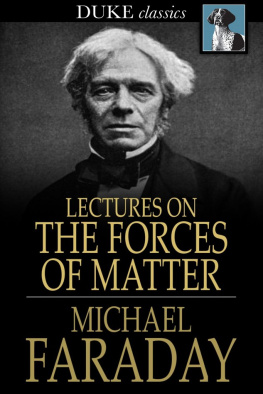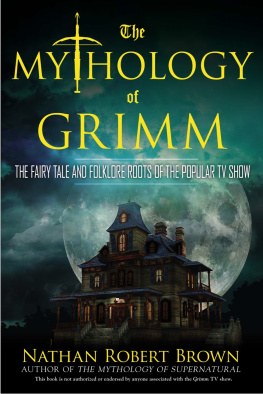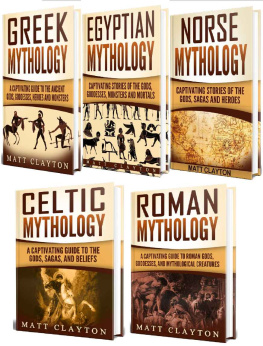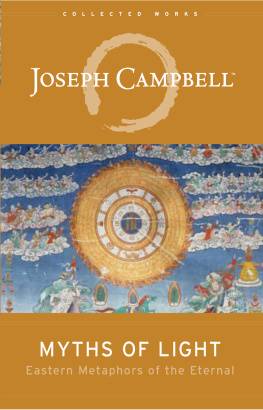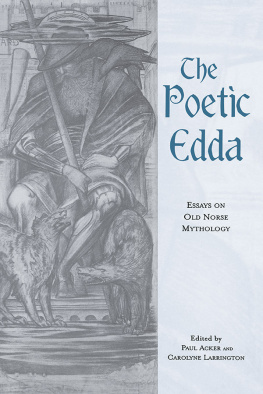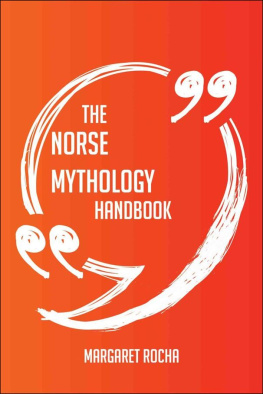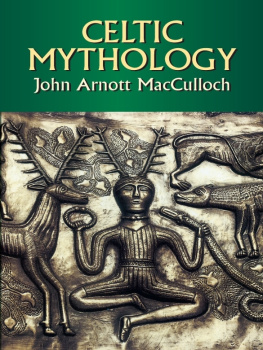Faraday - Edda, Volume 1 The Divine Mythology of the North Popular Studies in Mythology, Romance, and Folklore, No. 12
Here you can read online Faraday - Edda, Volume 1 The Divine Mythology of the North Popular Studies in Mythology, Romance, and Folklore, No. 12 full text of the book (entire story) in english for free. Download pdf and epub, get meaning, cover and reviews about this ebook. year: 2010, publisher: Project Gutenberg, genre: Detective and thriller. Description of the work, (preface) as well as reviews are available. Best literature library LitArk.com created for fans of good reading and offers a wide selection of genres:
Romance novel
Science fiction
Adventure
Detective
Science
History
Home and family
Prose
Art
Politics
Computer
Non-fiction
Religion
Business
Children
Humor
Choose a favorite category and find really read worthwhile books. Enjoy immersion in the world of imagination, feel the emotions of the characters or learn something new for yourself, make an fascinating discovery.
- Book:Edda, Volume 1 The Divine Mythology of the North Popular Studies in Mythology, Romance, and Folklore, No. 12
- Author:
- Publisher:Project Gutenberg
- Genre:
- Year:2010
- Rating:5 / 5
- Favourites:Add to favourites
- Your mark:
- 100
- 1
- 2
- 3
- 4
- 5
Edda, Volume 1 The Divine Mythology of the North Popular Studies in Mythology, Romance, and Folklore, No. 12: summary, description and annotation
We offer to read an annotation, description, summary or preface (depends on what the author of the book "Edda, Volume 1 The Divine Mythology of the North Popular Studies in Mythology, Romance, and Folklore, No. 12" wrote himself). If you haven't found the necessary information about the book — write in the comments, we will try to find it.
Edda, Volume 1 The Divine Mythology of the North Popular Studies in Mythology, Romance, and Folklore, No. 12 — read online for free the complete book (whole text) full work
Below is the text of the book, divided by pages. System saving the place of the last page read, allows you to conveniently read the book "Edda, Volume 1 The Divine Mythology of the North Popular Studies in Mythology, Romance, and Folklore, No. 12" online for free, without having to search again every time where you left off. Put a bookmark, and you can go to the page where you finished reading at any time.
Font size:
Interval:
Bookmark:
The Project Gutenberg EBook of The Edda, Vol. 1, by Winifred Faraday
This eBook is for the use of anyone anywhere at no cost and with
almost no restrictions whatsoever. You may copy it, give it away or
re-use it under the terms of the Project Gutenberg License included
with this eBook or online at www.gutenberg.net
Title: The Edda, Vol. 1
The Divine Mythology of the North, Popular Studies in Mythology,
Romance, and Folklore, No. 12
Author: Winifred Faraday
Release Date: July 23, 2004 [EBook #13007]
Language: English
*** START OF THIS PROJECT GUTENBERG EBOOK THE EDDA, VOL. 1 ***
Produced by Jeroen Hellingman and the Distributed Proofreaders Team.
Winifred Faraday, M.A.
1902
Some explanation is needed of the form of spelling I have adopted in transcribing Norse proper names. The spirants and are represented by th and d, as being more familiar to readers unacquainted with the original. Marks of vowel-length are in all cases omitted. The inflexional -r of the nominative singular masculine is also omitted, whether it appears as -r or is assimilated to a preceding consonant (as in Odinn, Eysteinn, Heindall, Egill) in the Norse form, with the single exception of the name Tyr, where I use the form which has become conventional in English.
Manchester ,
December 1901.
Page 1
The Icelandic Eddas are the only vernacular record of Germanic heathendom as it developed during the four centuries which in England saw the destruction of nearly all traces of the heathen system. The so-called Elder Edda is a collection of some thirty poems, mythic and heroic in substance, interspersed with short pieces of prose, which survives in a thirteenth-century MS., known as the Codex Regius, discovered in Iceland in 1642; to these are added other poems of similar character from other sources. The Younger Edda is a prose paraphrase of, and commentary on, these poems and others which are lost, together with a treatise on metre, written by the historian Snorri Sturluson about 1220.
This use of the word Edda is incorrect and unhistorical, though convenient and sanctioned by the use of several centuries. It was early used as a general term for the rules and materials for versemaking, and applied in this sense to Snorri's Page 2 work. When the poems on which his paraphrase is founded were discovered, Icelandic scholars by a misunderstanding applied the name to them also; and as they attributed the collection quite arbitrarily to the historian Saemund (10561133), it was long known as Saemundar Edda, a name now generally discarded in favour of the less misleading titles of Elder or Poetic Edda. From its application to this collection, the word derives a more extended use, (1) as a general term for Norse mythology; (2) as a convenient name to distinguish the simpler style of these anonymous narrative poems from the elaborate formality of the Skalds.
The poems of the Edda are certainly older than the MS., although the old opinion as to their high antiquity is untenable. The majority probably date from the tenth century in their present form; this dating does not necessitate the ascription of the shape in which the legends are presented, still less of their substance, to that period. With regard to the place of their composition opinions vary widely, Norway, the British Isles and Greenland having all found champions; but the evidence is rather questionable, and I incline to leave them to the country which has preserved them. They are possibly of popular origin; this, together with their epic or narrative character, would account for the striking absence from them of some of the chief characteristics of Skaldic poetry: the obscuring of Page 3 the sense by the elaborate interlacing of sentences and the extensive use of kennings or mythological synonyms, and the complication of the metre by such expedients as the conjunction of end-rhyme with alliteration. Eddie verse is governed solely by the latter, and the strophic arrangement is simple, only two forms occurring: (1) couplets of alliterative short lines; (2) six-line strophes, consisting of a couplet followed by a single short line, the whole repeated.
Roughly speaking, the first two-fifths of the MS. is mythological, the rest heroic. I propose to observe this distinction, and to deal in this study with the stories of the Gods. In this connexion, Snorri's Edda and the mythical Ynglinga Saga may also be considered, but as both were compiled a couple of centuries or more after the introduction of Christianity into Iceland, it is uncertain how much in them is literary explanation of tradition whose meaning was forgotten; some also, especially in Snorri, is probably pure invention, fairy tale rather than myth.
Many attempts have been made to prove that the material of the Edda is largely borrowed. The strength and distinction of Icelandic poetry rest rather on the fact that it is original and national and, like that of Greece, owes little to foreign sources; and that it began in the heathen age, before Christian or Romantic influences had touched Iceland. Valuable as the early Christian poetry Page 4 of England is, we look in vain there for the humour, the large-minded simplicity of motive, the suggestive character-drawing, the swift dramatic action, which are as conspicuous in many poems in the Edda as in many of the Sagas.
Omitting the heroic poems, there are in Codex Regius the following: (1) Of a more or less comprehensive character, Vluspa, Vafthrudnismal, Grimnismal, Lokasenna, Harbardsljod; (2) dealing with episodes, Hymiskvida, Thrymskvida, Skirnisfr. Havamal is a collection of proverbs, but contains two interpolations from mythical poems; Alvissmal, which, in the form of a dialogue between Thor and a dwarf Alviss, gives a list of synonyms, is a kind of mythologico-poetical glossary. Several of these poems are found in another thirteenth-century vellum fragment, with an additional one, variously styled Vegtamskvida or Baldr's Dreams; the great fourteenth-century codex Flateybook contains Hyndluljod, partly genealogical, partly an imitation of Vluspa; and one of the MSS. of Snorri's Edda gives us Rigsthula.
Vluspa, though not one of the earliest poems, forms an appropriate opening. Metrical considerations forbid an earlier date than the first quarter of the eleventh century, and the last few lines are still later. The material is, however, older: the poem is an outline, in allusions often obscure to us, of traditions and beliefs familiar to its first hearers. Page 5 The very bareness of the outline is sufficient proof that the material is not new. The framework is apparently imitated from that of the poem known as Baldr's Dreams, some lines from which are inserted in Vluspa. This older poem describes Odin's visit to the Sibyl in hell-gates to inquire into the future. He rides down to her tomb at the eastern door of Nifl-hell and chants spells, until she awakes and asks: What man unknown to me is that, who has troubled me with this weary journey? Snow has snowed on me, rain has beaten me, dew has drenched me, I have long been dead. He gives the name Wegtam, or Way-wise, and then follow question and answer until she discovers his identity and will say no more. In Vluspa there is no descriptive introduction, and no dialogue; the whole is spoken by the Sibyl, who plunges at once into her story, with only the explanatory words: Thou, Valfather, wouldst have me tell the ancient histories of men as far as I remember. She describes the creation of the world and sky by Bor's sons; the building by the Gods of a citadel in Ida-plain, and their age of innocence till three giant-maids brought greed of gold; the creation of the dwarfs; the creation of the first man and woman out of two trees by Odin, Hoeni and Lodur; the world-ash and the spring beside it where dwell the three Norns who order the fates of men. Then follows an allusion to the Page 6 war between the Aesir and the Vanir, the battle with the giants who had got possession of the goddess Freyja, and the breaking of bargains; an obscure reference to Mimi's spring where Odin left his eye as a pledge; and an enumeration of his war-maids or Valkyries. Turning to the future, the Sibyl prophesies the death of Baldr, the vengeance on his slayer, and the chaining of Loki, the doom of the Gods and the destruction of the world at the coming of the fire-giants and the release of Loki's children from captivity. The rest of the poem seems to be later; it tells how the earth shall rise again from the deep, and the Aesir dwell once more in Odin's halls, and there is a suggestion of Christian influence in it which is absent from the earlier part.
Font size:
Interval:
Bookmark:
Similar books «Edda, Volume 1 The Divine Mythology of the North Popular Studies in Mythology, Romance, and Folklore, No. 12»
Look at similar books to Edda, Volume 1 The Divine Mythology of the North Popular Studies in Mythology, Romance, and Folklore, No. 12. We have selected literature similar in name and meaning in the hope of providing readers with more options to find new, interesting, not yet read works.
Discussion, reviews of the book Edda, Volume 1 The Divine Mythology of the North Popular Studies in Mythology, Romance, and Folklore, No. 12 and just readers' own opinions. Leave your comments, write what you think about the work, its meaning or the main characters. Specify what exactly you liked and what you didn't like, and why you think so.


